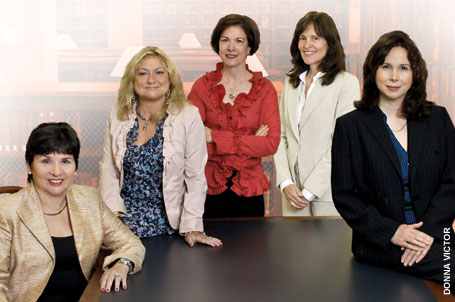Anne E. Burdick, M.D., M.P.H., laughs when she recalls how she came to lead the new telededermatology program at the University of Miami. One morning in 1993, an assistant handed her this message from her then chairman: “Someone wants to set up a new video-based clinic at Jackson Dermatology Clinic. Look into it. You’re the new medical director there.”
 |
| From left, Diana D. Cardenas, M.D., M.H.A., Sylvia Daunert, Pharm.D., Ph.D., Anne E. Burdick, M.D., M.P.H., Norma Kenyon, Ph.D., and Omaida Velazquez, M.D. |
With that, Burdick took the reins of the fledgling program, joining only a handful of women in leadership roles at the medical school. Nearly a decade later, when she became director of all of UM’s telemedicine programs, she asked then-Dean John Clarkson, M.D., to support her participation in Drexel University’s year-long Hedwig van Ameringen Executive Leadership in Academic Medicine (ELAM) Program for Women. The Philadelphia-based program was receiving excellent reviews in the C-suites of academia for helping talented women develop the professional and personal skills required to lead and manage in the complex health care environment.
“It turned out to be the most wonderful program,’’ said Burdick, who now bears the titles professor of dermatology, director of the leprosy program and—after a promotion by Dean Pascal J. Goldschmidt, M.D.—associate dean for telehealth and clinical outreach. “I have been successful here in large part because of ELAM.”
Men still hold significantly more leadership roles throughout the field of academic medicine nationally, but Goldschmidt, who arrived in 2006, and Sheri Keitz, M.D., Ph.D., senior associate dean for faculty affairs and associate vice president for human resources, are committed to having more women join their ranks. The dean has nominated and sponsored four more ELAM fellows from the Miller School, and Keitz is spearheading the creation of a mentorship program to enable more women faculty to follow the path Burdick paved.
For now, the Miller School’s ELAM fellows are a small but impressive group that, in addition to Burdick, includes:
Diana D. Cardenas, M.D., M.H.A., professor and chair of the Department of Rehabilitation Medicine (Class of 2008); Norma Kenyon, Ph.D., the Martin Kleiman Professor of Surgery, Microbiology and Immunology, and Biomedical Engi-neering, executive director of the Wallace H. Coulter Center for Translational Research, and senior associate dean for translational research (Class of 2010); Omaida Velazquez, M.D., professor of surgery, chief of the Division of Vascular and Endovascular Surgery, the David Kimmelman Endowed Chair in Vascular and Endovascular Surgery, and vice chair of research for the DeWitt Daughtry Family Department of Surgery (Class of 2011); and Sylvia Daunert, Pharm.D., Ph.D., professor and the Lucille P. Markey Chair of Biochemistry and Molecular Biology, who began ELAM last fall.
“If we don’t make a point of identifying and preparing many of our women faculty to become chiefs, heads of departments, and deans,” Goldschmidt said, “then academic medical institutions around the country will be shortchanged.”
Cardenas credits ELAM’s courses for making her a better department chair.
“For women who have any interest in top administrative positions—and many women do—ELAM is perfect,” Cardenas said.
Kenyon credits the program for creating a supportive and nurturing network: “We were in a room of 54 women who are all very bright and accomplished and who shared many of the same academic experiences,” Kenyon recalled of her ELAM class. “I learned as much from talking to them as I did from the formal educational process.”
Velazquez says programs like ELAM contribute to the promotion and retention of women. As she notes, many women graduate at the top of their medical school classes, “but as they progress to instructors, to assistant professors, to associate professors, to full professors, to achieving tenure, then to division chief all the way up to chair, there is a tremendous downward curve of attrition.”
That’s exactly why Keitz is making mentorship a significant part of the experience for women faculty—with much of it through Women in Academic Medicine, which encourages women faculty to meet and support each other. Part of the mission, Keitz notes, is to boost tenure for women faculty, which is at 12 percent now, compared with 30 percent for men.
“ELAM has had a great impact for a small number of women,” Keitz said. “But we have many talented women who can achieve at the highest level with the right mentoring and training, and we are going to do everything in our power to give that to them.”
|


